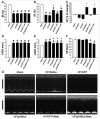Myocardial adeno-associated virus serotype 6-betaARKct gene therapy improves cardiac function and normalizes the neurohormonal axis in chronic heart failure
- PMID: 19103992
- PMCID: PMC2647661
- DOI: 10.1161/CIRCULATIONAHA.108.803999
Myocardial adeno-associated virus serotype 6-betaARKct gene therapy improves cardiac function and normalizes the neurohormonal axis in chronic heart failure
Abstract
Background: The upregulation of G protein-coupled receptor kinase 2 in failing myocardium appears to contribute to dysfunctional beta-adrenergic receptor (betaAR) signaling and cardiac function. The peptide betaARKct, which can inhibit the activation of G protein-coupled receptor kinase 2 and improve betaAR signaling, has been shown in transgenic models and short-term gene transfer experiments to rescue heart failure (HF). This study was designed to evaluate long-term betaARKct expression in HF with the use of stable myocardial gene delivery with adeno-associated virus serotype 6 (AAV6).
Methods and results: In HF rats, we delivered betaARKct or green fluorescent protein as a control via AAV6-mediated direct intramyocardial injection. We also treated groups with concurrent administration of the beta-blocker metoprolol. We found robust and long-term transgene expression in the left ventricle at least 12 weeks after delivery. betaARKct significantly improved cardiac contractility and reversed left ventricular remodeling, which was accompanied by a normalization of the neurohormonal (catecholamines and aldosterone) status of the chronic HF animals, including normalization of cardiac betaAR signaling. Addition of metoprolol neither enhanced nor decreased betaARKct-mediated beneficial effects, although metoprolol alone, despite not improving contractility, prevented further deterioration of the left ventricle.
Conclusions: Long-term cardiac AAV6-betaARKct gene therapy in HF results in sustained improvement of global cardiac function and reversal of remodeling at least in part as a result of a normalization of the neurohormonal signaling axis. In addition, betaARKct alone improves outcomes more than a beta-blocker alone, whereas both treatments are compatible. These findings show that betaARKct gene therapy can be of long-term therapeutic value in HF.
Figures






Similar articles
-
AAV6.βARKct cardiac gene therapy ameliorates cardiac function and normalizes the catecholaminergic axis in a clinically relevant large animal heart failure model.Eur Heart J. 2013 May;34(19):1437-47. doi: 10.1093/eurheartj/ehr447. Epub 2012 Jan 19. Eur Heart J. 2013. PMID: 22261894 Free PMC article.
-
The inotropic peptide βARKct improves βAR responsiveness in normal and failing cardiomyocytes through G(βγ)-mediated L-type calcium current disinhibition.Circ Res. 2011 Jan 7;108(1):27-39. doi: 10.1161/CIRCRESAHA.110.225201. Epub 2010 Nov 24. Circ Res. 2011. PMID: 21106943 Free PMC article.
-
AAV6-βARKct gene delivery mediated by molecular cardiac surgery with recirculating delivery (MCARD) in sheep results in robust gene expression and increased adrenergic reserve.J Thorac Cardiovasc Surg. 2012 Mar;143(3):720-726.e3. doi: 10.1016/j.jtcvs.2011.08.048. Epub 2011 Dec 3. J Thorac Cardiovasc Surg. 2012. PMID: 22143102 Free PMC article.
-
GRK2 as a novel gene therapy target in heart failure.J Mol Cell Cardiol. 2011 May;50(5):785-92. doi: 10.1016/j.yjmcc.2010.08.014. Epub 2010 Aug 25. J Mol Cell Cardiol. 2011. PMID: 20800067 Free PMC article. Review.
-
betaARKct: a therapeutic approach for improved adrenergic signaling and function in heart disease.J Cardiovasc Transl Res. 2010 Oct;3(5):499-506. doi: 10.1007/s12265-010-9206-6. Epub 2010 Jul 10. J Cardiovasc Transl Res. 2010. PMID: 20623214 Review.
Cited by
-
GRK2 and β-arrestins in cardiovascular disease: Something old, something new.Am J Cardiovasc Dis. 2011;1(2):126-37. Epub 2011 Jun 28. Am J Cardiovasc Dis. 2011. PMID: 22254193 Free PMC article.
-
Gene therapy delivery systems for enhancing viral and nonviral vectors for cardiac diseases: current concepts and future applications.Hum Gene Ther. 2013 Nov;24(11):914-27. doi: 10.1089/hum.2013.2517. Hum Gene Ther. 2013. PMID: 24164239 Free PMC article. Review.
-
Multiple functions of G protein-coupled receptor kinases.J Mol Signal. 2014 Mar 6;9(1):1. doi: 10.1186/1750-2187-9-1. J Mol Signal. 2014. PMID: 24597858 Free PMC article.
-
GRK2 in the heart: a GPCR kinase and beyond.Antioxid Redox Signal. 2014 Nov 10;21(14):2032-43. doi: 10.1089/ars.2014.5876. Epub 2014 May 13. Antioxid Redox Signal. 2014. PMID: 24702056 Free PMC article. Review.
-
Neuro-hormonal effects of physical activity in the elderly.Front Physiol. 2013 Dec 20;4:378. doi: 10.3389/fphys.2013.00378. Front Physiol. 2013. PMID: 24391595 Free PMC article. Review.
References
-
- Levy D, Kenchaiah S, Larson MG, Benjamin EJ, Kupka MJ, Ho KK, Murabito JM, Vasan RS. Long-term trends in the incidence of and survival with heart failure. N Engl J Med. 2002;347:1397–1402. - PubMed
-
- Harnad E, Mather PJ, Srinivasan S, Rubin S, Whellan DJ, Feldman AM. Pharmacologic therapy of chronic heart failure. Am J Cardiovasc Drugs. 2007;7:235–248. - PubMed
-
- Rockman HA, Koch WJ, Lefkowitz RJ. Seven-transmembrane-spanning receptors and heart function. Nature. 2002;415:206–212. - PubMed
-
- Pierce KL, Premont RT, Lefkowitz RJ. Seven-transmembrane receptors. Nat Rev Mol Cell Biol. 2002;3:639–650. - PubMed
Publication types
MeSH terms
Substances
Grants and funding
LinkOut - more resources
Full Text Sources
Other Literature Sources
Medical
Research Materials
Miscellaneous

